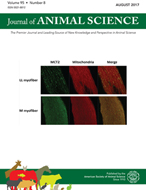-
Views
-
Cite
Cite
T. K. Chung, D. H. Baker, Maximal portion of the young pig's sulfur amino acid requirement that can be furnished by cystine, Journal of Animal Science, Volume 70, Issue 4, April 1992, Pages 1182–1187, https://doi.org/10.2527/1992.7041182x
Close - Share Icon Share
Abstract
Three pig experiments were conducted using a chemically defined, amino acid diet under conditions in which all nutrients were 100% bioavailable to assess the maximal portion of the sulfur amino acid (SAA) requirement that could be furnished by cystine (Cys). In Exp. 1, a methionine (Met)-deficient diet containing .12% L-Met and .40% L-Cys was supplemented with graded levels of L-Met. Pigs weighing 10 kg initially responded quadratically (P < .05) to Met supplementation. A two-slope, broken-line regression model (weight gain regressed on percentage of dietary Met) estimated an inflection point at .23% dietary Met. A constant level of .46% dietary SAA with differing Met:Cys weight (wt:wt) ratios was used in Exp. 2. Pigs fed Met:Cys ratios of 60:40 and 50:50 had similar (P > .05) weight gains, but pigs fed a 40:60 Met:Cys ratio gained less (P < .05) than those fed the other diets. Maintaining dietary sulfur at .111% in Exp. 3, pigs fed Met:Cys ratios (wt:wt) of 100:0, 55:45, 50:50, and 45:55 gained weight at similar (P > .05) rates, but pigs fed the 45:55 Met:Cys ratio had a tendency to produce lower weight gains. Regardless of whether a constant dietary SAA or sulfur level was maintained, no more than 50% of the young pig's total SAA requirement (wt:wt) could be furnished by Cys.





